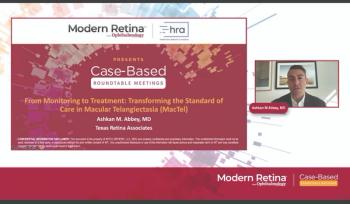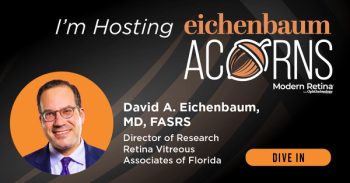
First FDA-approved MacTel treatment performed
Neurotech Pharmaceuticals performs the first ENCELTO procedure.
Neurotech Pharmaceuticals recently announced the first commercial manufacturing, shipment, and surgical procedure of the first and only FDA-approved treatment for adults with idiopathic macular telangiectasia type 2 (MacTel), ENCELTO (revakinagene taroretcel-lwey).1
“Performing the first ENCELTO surgery for a patient with MacTel outside a clinical trial is an important milestone. For the first time, we can offer a valuable and durable treatment option for patients, one that slows their loss of photoreceptors and maintains more visual function over time,” Charles C. Wykoff, MD, PhD, Retinal Consultants of Texas, Houston, said in a press release.
Related content:
“Many patients with MacTel experience gradual and progressive functional declines over time, and it is exciting to offer an option to change the course of their disease.”
A bilateral, neurodegenerative disease in adults, MacTel has “characterized local retinal degeneration that causes the gradual loss of cells in the retina, resulting in vision loss and secondary alterations of the retinal vasculature,” a press release said.
Designed to provide long-term, sustained delivery of therapeutic proteins for the treatment of chronic eye disease, ENCELTO is an encapsulated cell-based gene therapy that uses Neurotech’s ECT platform, which is surgically inserted. The ECT platform is made of small, semipermeable capsules containing the proprietary allogeneic retinal pigment epithelium (RPE) cells, which are genetically engineered to produce specific therapeutic proteins for targeted disease treatment.1
“This is a huge milestone for people living with MacTel. For the first time, there is an FDA-approved treatment option that could change what is possible for patients,” Richard Small, CEO of Neurotech, said in a press release.1
“We have been working toward this for years, and seeing it become a reality is incredibly exciting for the Neurotech team and, most importantly, for the patients who may benefit.”
Increased awareness and diagnosis of MacTel
The availability of an FDA-approved treatment will likely drive greater awareness of MacTel among eye care professionals.2
“Historically, MacTel has been underdiagnosed due to its subtle clinical presentation, but the introduction of an intervention will encourage earlier detection and referral patterns among ophthalmologists and optometrists,” said Rishi P. Singh, MD, FASRS, who is vice president/chief medical officer of Martin North and South Hospitals; professor of ophthalmology, Cleveland Clinic Lerner College of Medicine; Cleveland Clinic Martin Health in Stuart, Florida. He is also a member of the editorial advisory board for Modern Retina. This could lead to improved patient outcomes as we diagnose and manage the disease at earlier stages, he noted.2
“We view the Neurotech device as a platform technology which will be useful for delivering not only neurotrophics but perhaps other molecules, like angiostatics or other neurotrophics other than CNTF to treat other neurovascular glial degenerative diseases like glaucoma, age-related macular degeneration, retinitis pigmentosa,” Martin Friedlander, MD, PhD, who is professor, Department of Molecular Medicine, Scripps Research Institute; chief, Retina Services, Division of Ophthalmology, Scripps Clinic; and president, Lowy Medical Research Institute (LMRI), La Jolla, California, said in a
Related content:
“Approval for this treatment for this disease that is incurable right now...will be a wonderful situation for retina specialists and for the patients. First of all for the patients, and then for the retina specialists who will be able to provide treatment for this incurable disease,” said Anat Loewenstein, MD, professor and head of retina, Division of Ophthalmology, Tel Aviv Medical Center, VP Ambulatory Services; president, EURETINA; Sydney Fox Chair of Ophthalmology, Tel Aviv University; and president, Israeli Ophthalmological Society, Tel Aviv, Israel. She is also a member of the editorial advisory board for Modern Retina.2
“By delivering continuous neurotrophic support to the retina, this device offers a novel approach that could slow disease progression and help preserve vision in affected individuals. This shift from passive monitoring to an active treatment strategy is a game changer for both patients and clinicians,” Singh said.2
Important safety information
Who should not receive an ENCELTO surgical implant?1
- ENCELTO has not been tested in pediatric patients or pregnant people.
- The outpatient surgical procedure should not be performed if a patient is experiencing an active or suspected eye infection.
- Patients should not receive ENCELTO if there is a known patient history of hypersensitivity to Endothelial Serum Free Media (Endo-SFM).
Before receiving ENCELTO, eye surgeons should be aware of all patient medical conditions, including the following:2
- Pregnancy or plans to become pregnant. Although studies have shown that rhCNTF does not enter the bloodstream, its effects on an unborn baby have not been fully studied.
- Breastfeeding or plans to breastfeed. It is not known whether rhCNTF passes into breast milk.
- Any current infections.
- Currently taking or have recently taken medicines that lower the chance of blood clots forming in the body such as warfarin, low or regular doses of aspirin, or nonsteroidal anti-inflammatory drugs (NSAIDs).
What should patients avoid while taking ENCELTO?
- Immediately postoperative:
- Avoid lifting more than 20 lb for 1 week
- Keep water out of the eye for 1 week
- Wear eye protection during the day and an eye shield at night for 1 week.
- Do not drive or use machinery until the eye shield has been removed and the eye surgeon clears the patient that vision has recovered to an acceptable level.
- Postoperative care:
- Use a topical antibiotic solution at a frequency of 1 drop 4 times a day for 7 days.
- Use a steroid drop taper of prednisolone acetate 1% (or equivalent) starting the day after surgery with the following taper:
- 1 drop 4 times a day for the first 7 days;
- 1 drop 3 times a day for the next 7 days;
- 1 drop 2 times a day for the next 7 days;
- 1 drop once a day for the last 7 days.
Potential adverse effects of ENCELTO and the surgical insertion include but are not limited to:
- Endophthalmitis (eye infection)
- Retinal tear and detachment (the retina tears and potentially separates from the eye wall, resulting in vision loss)
- Vitreous hemorrhage (bleeding within the central cavity of the eye)
- Implant extrusion (when the ENCELTO begins to work its way out of the eye)
- Suture-related issues (such as suture-related eye irritation or exposure of sutures)
- Temporary or permanent loss of vision
- Accelerated cataract formation (clouding of the lens of the eye)
- Delayed dark adaptation (the eye’s ability to adjust from bright lighting conditions to dark lighting conditions)
Common symptoms to experience following ENCELTO surgery:
- Sensation of something in the eye
- Eye redness
- Eye irritation
- Eye dryness
- Eye discharge
- Mild to moderate eye pain or discomfort
- Floaters
- Headache
References:
First FDA-Approved Treatment for MacTel Performed. August 11, 2025.
https://www.businesswire.com/news/home/20250811189087/en/First-FDA-Approved-Treatment-for-MacTel-Performed . Accessed August 12, 2025.Friedlander M, Loewenstein A, Rafieetary M, Rishi, Stevenson S. A new era for MacTel: Clinicians react to FDA approval of revakinagene taroretcel-lwey. Ophthalmology Times. Published March 10, 2025. Accessed August 12, 2025. https://www.ophthalmologytimes.com/view/a-new-era-for-mactel-clinicians-react-to-fda-approval-of-revakinagene-taroretcel-lwey
Newsletter
Keep your retina practice on the forefront—subscribe for expert analysis and emerging trends in retinal disease management.












































